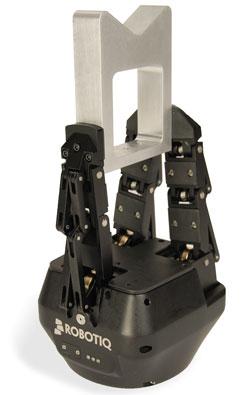- FMA
- The Fabricator
- FABTECH
- Canadian Metalworking
Robotic Handling
What you need to know about tooling
- July 17, 2012
- Article
- Automation and Software

The fingers of a three-finger gripper can be controlled independently,enabling a range of parts to be held.
End-of-arm tooling (EOAT) decisions literally can make or break any robotic production process. Because the choices made affect productivity, profitability, and quality, Canadian Industrial Machinery asked expert Samuel Bouchard, president of Robotiq, St-Nicolas, Que., to discuss some of the key factors in robotic gripping technology.
CIM: What is the difference between a multiple-use gripper and a custom, part-specific gripper?
Bouchard: A multiple-use gripper can be used to pick a wide range of parts with an adjustment of the stroke, force, and grip type. This becomes important when one robot has to pick a lot of different parts. In these situations, the robot processes several parts in one station (assembly, kitting) or processes only one part but with frequent changeovers (machine load/unload).
The greatest benefit of a multiple-use, programmable gripper is that it reduces the changeover time to zero. You just need to load the program for the new part; there is no need to change tools.
A part-specific gripper is used when you need extreme mechanical repeatability and you can afford to pick a limited number of parts with it. It usually has limited stroke, control options, and custom-made fingers to match the part features.
CIM: Your company makes two- and three-finger grippers. What are the differences in design and functionality?
Bouchard: Both have self-adaptive fingers that can adapt automatically to different shapes. They are both electric with controllable finger position, speed, and force. Both also are used in high-mix applications such as assembly and kitting, as well as machine load/unload.
The three-finger gripper can pick a wider range of parts. It has four motors, and each finger can be controlled individually. The controller also is embedded. Each finger has three phalanxes so more contact points can distribute the pressure on fragile parts.
The two-finger gripper is smaller and the controller is located externally to enable the smaller form and create a lighter gripper. One motor drives the two fingers simultaneously so it is self-centering for symmetric parts.
CIM: How does gripper selection affect overall robot performance?
Bouchard: Just like the tire is the only thing between the car and the road, the gripper is what comes between the robot and its work. This means it can have a big impact on the overall performance of the robot. It can also have important financial impact if you consider the changeover times it can save and the flexibility it can bring when you add new products.
CIM: How does gripper selection affect programming?
Bouchard: Conventional grippers use discrete inputs and outputs. Servo grippers involve more programming because you can control more parameters and receive more feedback. Our grippers are supported by several communication protocols (EtherNet/IP™, TCP/IP, DeviceNet™, CANopen®, EtherCAT®, and RS-232).
The good thing is that sometimes the feedback you get from the electric gripper replaces extra sensors you would have needed with conventional grippers, such as object detection sensors or a strain gauge.

The gripper motor’s current is proportional to the driving torque of the finger and is specified in the program. This is what enables the gripper to hold delicate parts gently.
CIM: How are thin-walled or delicate parts best held?
Bouchard: The force applied by the fingers is a programmable parameter. The motor current, which is proportional to the driving torque of the finger, is specified in the program. This is what enables the gripper to hold delicate parts gently.
CIM: How can heavy parts be manipulated correctly?
Bouchard: When the grippers can do an encompassing grip, they don’t rely on friction anymore to hold the part. The fingers are self-locking and can withstand higher payload than the motors could alone.
CIM: Is proper contact between the gripper and the part important, and how is it accomplished?
Bouchard: It is always necessary to finish the part reliably and safely. It is done through proper gripper design and the proper robot programming. Our grippers return information on the part contact that the program can use.
The gripper is able to determine when it has gripped an object. This is useful to determine if the pickup procedure was performed correctly and if the robot can move to the next step of its program. In some cases, however, it is also useful to verify if the gripper still has the object after the robot executes a motion.
The fingers also come with rubber pads to ensure better contact.
CIM: What type of feedback can the gripper supply, and how can this information be used?
Bouchard: Encoder position, motor current, and part detection all are types of feedback the gripper returns to the control. This information can be used to make sure the right part is there and even to make sure a part is there at all.
CIM: How should gripper maintenance be performed?
Bouchard: The gripper, like the rest of the cell, should be inspected periodically to detect upcoming maintenance issues. Improper maintenance can affect the downtimes and have major financial impact. On the gripper, internal worm gears need to be greased every so often. Pads also need to be replaced periodically.
subscribe now


Keep up to date with the latest news, events, and technology for all things metal from our pair of monthly magazines written specifically for Canadian manufacturers!
Start Your Free Subscription- Trending Articles
- Industry Events
MME Winnipeg
- April 30, 2024
- Winnipeg, ON Canada
CTMA Economic Uncertainty: Helping You Navigate Windsor Seminar
- April 30, 2024
- Windsor, ON Canada
CTMA Economic Uncertainty: Helping You Navigate Kitchener Seminar
- May 2, 2024
- Kitchener, ON Canada
Automate 2024
- May 6 - 9, 2024
- Chicago, IL
ANCA Open House
- May 7 - 8, 2024
- Wixom, MI














